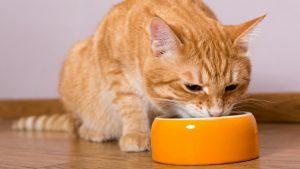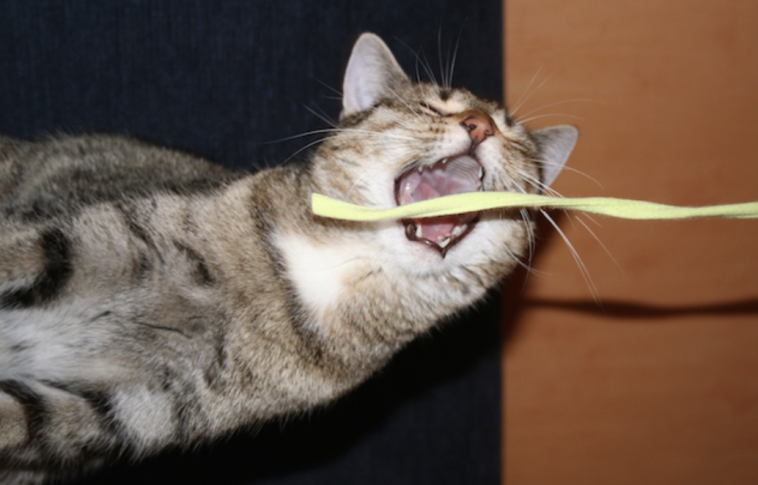Plastics are up there in the list of fascinating “must-eat” items for a good number of cats. In my case, every time I set down a plastic bag of groceries or open the plastic seal of a container of water, two furballs in my clowder suddenly appear out of nowhere and two sets of eyes gleam at me with obvious excitement. Plastic materials that cats love include plastic bags, cellophane tape, bread bags, plastic cups, plastic straws, candy wrappers… Even harder items like baller bands and small detachable parts of toys, to name a few. This article will help advise you on what action to take if your cat ate a piece of plastic. The threat that swallowing plastic has is dependent on the quantity and type in which the cat digests.

What To Do After Your Cat Eats Plastic?
1. Small, Soft Plastic — Wait and Check The Litterbox
If your cat ate a piece of plastic, the next course of action depends on what type of plastic he ate. If this is a small piece of soft plastic then you have the option to wait and observe your cat. It takes between ten to twenty-four hours for material to pass through the digestive tract, sometimes up to four days. You may want to call your veterinarian to ask advice about giving your
cat laxatives or fibre dietary supplements that

may help the food and other materials eaten to move along faster.
Check the litterbox regularly for signs of the plastic material. Usually, cats expel these small foreign bodies with no complications. Remember though that waiting and observing is a good idea only when the cat looks happy, going about his regular business and is showing no obvious signs of distress. Never give anything to your cat that will force him to vomit. If he needs induced vomiting then you must leave this to a veterinarian.
2. My Cat Ate A Piece Of Plastic Big Piece & Hard Plastic — Watch Out For Signs of Gut Obstruction and Injury, Take to Vet
If your cat ate a piece of plastic -bigger piece of soft plastic, then there is the possibility of folding of this material into a linear type of foreign body like a string, ribbon, or rubber band. The danger here is if this string-like plastic becomes trapped in either the base of the tongue or at the junction between the stomach and intestines. This can cause an obstruction that, if left unresolved for some time, can result in some parts of the digestive system dying.
Therefore, a prompt visit to the veterinarian is in order especially if your cat ate a piece of plastic is showing any of these signs of obstruction: vomiting, retching, loss of interest in activity and food, abdomen is painful to the touch, diarrhea (when the obstruction is partial) or constipation (if the obstruction is complete). Just in case you see a piece of plastic hanging from either your cat’s mouth or anus, do not pull on it because its other end might be trapped further in the digestive system and pulling may cause more injury.
If your cat ate a piece of hard plastic, big or small, take the cat to the veterinarian immediately. This is because hard objects may cause injury to the walls of the digestive tract as they go along. If wounds form on the walls, bacteria from the gut can have easy access into the bloodstream and cause a generalized infection. The veterinarian can take a series of x-rays to identify the location of the plastic. If it is still in the stomach, it may be removed by
endoscopy only as compared to when the plastic has moved into the intestines already which will require surgery.
 3. Have Vet Check Kitty’s Liver and Kidneys, Plastics May Be Toxic
3. Have Vet Check Kitty’s Liver and Kidneys, Plastics May Be Toxic
Regardless if your cat passed the plastic uneventfully or had an obstruction which needed medical or surgical intervention. It is recommended to talk with your veterinarian for testing of your cat’s liver and kidneys because plastics, when subjected to the digestive juices, may release toxic chemicals that can damage these two organs. Your veterinarian can get a blood sample and do these tests. It is always better to be safe than sorry. These two organs will show signs of dysfunction only when the damage is quite extensive already. It will be easier to deal with a problem in the liver or kidney while it is still just starting.
Why Is Eating Plastic Tempting For Some Cats?
If I could only ask my two furballs directly, I would have! Different theories suggest why my cat ate a piece of plastic. A bag of groceries can have a residual scent of food items placed inside so cats try to eat them. Bioplastics are made from vegetable fats and oils and some animal by-products and cats can pick up this scent. Possibly it is the crackling sound that plastic makes when chewed that cats find enticing. You should take a chronic plastic muncher to the veterinarian for a check-up as dental problems and nutritional deficiencies can contribute to the development of this condition. Ruling out organic problems in the cat, this behaviour is sometimes due to boredom or a form of compulsive behaviour.

How To Stop a Cat From Eating Plastic?
Cats cannot really make the association that “I ate plastic that is why I feel unwell”. So it is up to us cat parents to take responsibility for our cats’ safety keeping them away from plastics. Keep plastics that your cats prefer to chew on safely stored and under lock and key. Note, some cats are even able to open cabinet doors and drawers. Give kitty safe toys to distract him and play with him to dissipate his energy. This will help keep his mind away from plastics. You can also try to make plastics unappealing for him by spraying it with bitter substances. You must make sure that you check with your veterinarian first for what substances they’d recommend. Hopefully, kitty will eventually form the association that plastics taste bad and stay away from them!
You might also be interested in:
My Cat Ate Styrofoam

 may help the food and other materials eaten to move along faster.
Check the litterbox regularly for signs of the plastic material. Usually, cats expel these small foreign bodies with no complications. Remember though that waiting and observing is a good idea only when the cat looks happy, going about his regular business and is showing no obvious signs of distress. Never give anything to your cat that will force him to vomit. If he needs induced vomiting then you must leave this to a veterinarian.
may help the food and other materials eaten to move along faster.
Check the litterbox regularly for signs of the plastic material. Usually, cats expel these small foreign bodies with no complications. Remember though that waiting and observing is a good idea only when the cat looks happy, going about his regular business and is showing no obvious signs of distress. Never give anything to your cat that will force him to vomit. If he needs induced vomiting then you must leave this to a veterinarian.
 3. Have Vet Check Kitty’s Liver and Kidneys, Plastics May Be Toxic
3. Have Vet Check Kitty’s Liver and Kidneys, Plastics May Be Toxic

